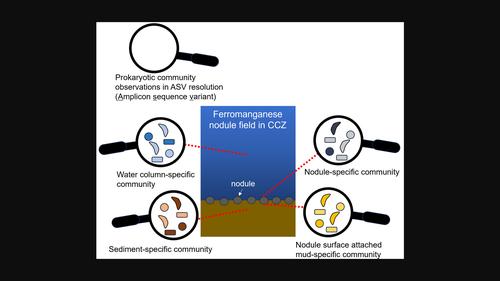当前位置:
X-MOL 学术
›
Environ. MicroBiol. Rep
›
论文详情
Our official English website, www.x-mol.net, welcomes your feedback! (Note: you will need to create a separate account there.)
Population-level prokaryotic community structures associated with ferromanganese nodules in the Clarion-Clipperton Zone (Pacific Ocean) revealed by 16S rRNA gene amplicon sequencing
Environmental Microbiology Reports ( IF 3.3 ) Pub Date : 2023-12-26 , DOI: 10.1111/1758-2229.13224 Kento Tominaga 1 , Hiroaki Takebe 1 , Chisato Murakami 2 , Akira Tsune 2 , Takahiko Okamura 3 , Takuji Ikegami 3 , Yosuke Onishi 3 , Ryoma Kamikawa 1 , Takashi Yoshida 1
Environmental Microbiology Reports ( IF 3.3 ) Pub Date : 2023-12-26 , DOI: 10.1111/1758-2229.13224 Kento Tominaga 1 , Hiroaki Takebe 1 , Chisato Murakami 2 , Akira Tsune 2 , Takahiko Okamura 3 , Takuji Ikegami 3 , Yosuke Onishi 3 , Ryoma Kamikawa 1 , Takashi Yoshida 1
Affiliation

|
Although deep-sea ferromanganese nodules are a potential resource for exploitation, their formation mechanisms remain unclear. Several nodule-associated prokaryotic species have been identified by amplicon sequencing of 16S rRNA genes and are assumed to contribute to nodule formation. However, the recent development of amplicon sequence variant (ASV)-level monitoring revealed that closely related prokaryotic populations within an operational taxonomic unit often exhibit distinct ecological properties. Thus, conventional species-level monitoring might have overlooked nodule-specific populations when distinct populations of the same species were present in surrounding environments. Herein, we examined the prokaryotic community diversity of nodules and surrounding environments at the Clarion-Clipperton Zone in Japanese licensed areas by 16S rRNA gene amplicon sequencing with ASV-level resolution for three cruises from 2017 to 2019. Prokaryotic community composition and diversity were distinct by habitat type: nodule, nodule-surface mud, sediment, bottom water and water column. Most ASVs (~80%) were habitat-specific. We identified 178 nodule-associated ASVs and 41 ASVs associated with nodule-surface mud via linear discriminant effect size analysis. Moreover, several ASVs, such as members of SAR324 and Woeseia, were highly specific to nodules. These nodule-specific ASVs are promising targets for future investigation of the nodule formation process.
中文翻译:

16S rRNA 基因扩增子测序揭示了克拉里昂-克利珀顿区(太平洋)与铁锰结核相关的种群水平原核生物群落结构
尽管深海铁锰结核是一种潜在的开发资源,但其形成机制仍不清楚。通过 16S rRNA 基因的扩增子测序已鉴定出几种与根瘤相关的原核生物物种,并被认为有助于根瘤的形成。然而,扩增子序列变异(ASV)水平监测的最新发展表明,操作分类单元内密切相关的原核生物种群通常表现出独特的生态特性。因此,当周围环境中存在同一物种的不同种群时,传统的物种级监测可能会忽略结核特定种群。在此,我们通过 2017 年至 2019 年三趟航行的 16S rRNA 基因扩增子测序和 ASV 级分辨率,检查了日本许可区域克拉里昂-克利珀顿区的结核和周围环境的原核生物群落多样性。生境类型:结核、结核表层泥、沉积物、底水和水柱。大多数 ASV (~80%) 都是针对特定栖息地的。通过线性判别效应大小分析,我们识别出 178 个与结核相关的 ASV 和 41 个与结核表面泥浆相关的 ASV。此外,一些 ASV,例如 SAR324 和Woeseia的成员,对结节具有高度特异性。这些结核特异性 ASV 是未来研究结核形成过程的有希望的目标。
更新日期:2023-12-26
中文翻译:

16S rRNA 基因扩增子测序揭示了克拉里昂-克利珀顿区(太平洋)与铁锰结核相关的种群水平原核生物群落结构
尽管深海铁锰结核是一种潜在的开发资源,但其形成机制仍不清楚。通过 16S rRNA 基因的扩增子测序已鉴定出几种与根瘤相关的原核生物物种,并被认为有助于根瘤的形成。然而,扩增子序列变异(ASV)水平监测的最新发展表明,操作分类单元内密切相关的原核生物种群通常表现出独特的生态特性。因此,当周围环境中存在同一物种的不同种群时,传统的物种级监测可能会忽略结核特定种群。在此,我们通过 2017 年至 2019 年三趟航行的 16S rRNA 基因扩增子测序和 ASV 级分辨率,检查了日本许可区域克拉里昂-克利珀顿区的结核和周围环境的原核生物群落多样性。生境类型:结核、结核表层泥、沉积物、底水和水柱。大多数 ASV (~80%) 都是针对特定栖息地的。通过线性判别效应大小分析,我们识别出 178 个与结核相关的 ASV 和 41 个与结核表面泥浆相关的 ASV。此外,一些 ASV,例如 SAR324 和Woeseia的成员,对结节具有高度特异性。这些结核特异性 ASV 是未来研究结核形成过程的有希望的目标。



























 京公网安备 11010802027423号
京公网安备 11010802027423号